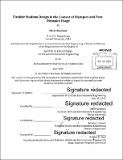Flexible stadium design in the context of Olympics and Post-Olympics usage
Author(s)
Beacham, Oliver (Oliver Edward)
DownloadFull printable version (6.651Mb)
Other Contributors
Massachusetts Institute of Technology. Department of Civil and Environmental Engineering.
Advisor
Pierre Ghisbain and Jerome J. Connor.
Terms of use
Metadata
Show full item recordAbstract
The design of the London Olympic Stadium for the 2012 Summer Olympic Games represented a shift in traditional stadium design for major sport events on the scale of the Olympics or World Cup. Emphasising design with a focus towards post-Olympics usage, the London Olympic Stadium through features like a demountable second seating tier, reclaimed steel elements, and structurally isolated fagade, set a strong precedent for flexible Olympics stadium construction. The goal of this thesis is to quantitatively explore options to push the boundaries of flexible stadium design, easing the renovation process required to transition stadiums from Olympics to post-Olympics usage. Through case study design examples, this thesis explores the effect bolted rather than welded connections can have on the design of stadium grandstands. Evaluated for both strength and serviceability, this thesis applies work demonstrating the pros and cons of bolted connections in traditional braced frame structures to stadium grandstands. Finally, this thesis explores the opportunity events like the Olympics provide to perform a probabilistic performance based design on an elliptical roof truss system. Given current building codes specify loads intended for use in the design of permanent structures, this thesis breaks down building code methodology in an attempt to determine loads more appropriate for use in the design of buildings with intended life spans on the order of an Olympic cycle (four years). Looking specifically at a stadium structural system typically controlled by wind and snow loads, this thesis attempts to quantify the material savings possible when designing a structure using performance rather than code based design.
Description
Thesis: M. Eng., Massachusetts Institute of Technology, Department of Civil and Environmental Engineering, 2015. Cataloged from PDF version of thesis. Includes bibliographical references (pages 43-45).
Date issued
2015Department
Massachusetts Institute of Technology. Department of Civil and Environmental EngineeringPublisher
Massachusetts Institute of Technology
Keywords
Civil and Environmental Engineering.